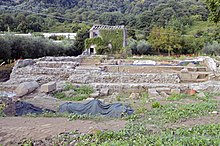Temple of Diana (Nemi)
Archaeological site in Nemi, Italy From Wikipedia, the free encyclopedia
Archaeological site in Nemi, Italy From Wikipedia, the free encyclopedia
The Temple of Diana Nemorensis was part of an ancient Italic monumental sanctuary erected around 300 BC and dedicated to the goddess Diana.[1] It was a popular place of worship until the late imperial age.
 | |
| Location | Lazio, Italy |
|---|---|
| Region | Provincia di Roma |
| Coordinates | 41°43′28″N 12°42′33″E |
| Type | sanctuary |
| History | |
| Periods | Roman Republic Roman Empire |
| Site notes | |
| Excavation dates | yes |
| Public access | yes |




The temple was situated on the northern shore of Lake Nemi, beneath the rim of the crater and the modern city of Nemi.[2]
Worship of Diana at Nemi may have flourished from at least the 6th century BC.[3]
The sanctuary was held by the Latin cities in common (the Latin League) and presided over by the Rex Nemorensis.[4] It was in the territory of the nearby town of Aricia which led to the town's development as an influential and affluent centre of healing and medicine.
The temple of Diana Nemorensis was preceded by the sacred grove of Aricia[5] in which there stood a carved cult image which survived until as late as 43 BC when it was reflected in coinage.[6] The Italic type of the triform cult image of Diana Nemorensis was shown in a sequence of later Republican period coins connected with a gens from Aricia.[7]
A three-day festival to Diana, the Nemoralia, was held yearly on the Ides of August from at least the 6th century BC, coinciding with the traditional founding date.[8] Records from the 1st century BC describe worshippers traveling to the sanctuary carrying torches and garlands.[9] Diana's festival eventually became widely celebrated throughout Italy, including at the Temple of Diana on the Aventine Hill in Rome.
The temple was built in about 300 BC and was noted by Vitruvius as being archaic and "Etruscan" in its form.[10] It continued in use until the late Roman Empire period when it was abandoned with the imposition of Christianity. Portions of its marbles and decorations were removed and the area of the temple was gradually covered by forest and generally left undisturbed for centuries.
Amateur, often foreign, archaeological excavations of the site began in the 1600s.[11][12] As a result, statues of splendid workmanship are now found scattered in many museums such as the University of Pennsylvania,[13] the Museum of Fine Arts (Boston) or in European museums such as the Nottingham Castle museum and the Ny Carlsberg Glyptotek.
A number of diminutive bronze statues of draped women and men, each holding libation bowls and incense boxes were found here, four of which are now in the British Museum's collection.[14]
Diana the Healer
This sanctuary was sacred to one of Diana’s epithets known as Diana the Healer. Diana’s role as a healer came about with the mythology of Hippolytus and his resurrection.[15] This mythology along with a similarity in healing practices, is also the reason why Diana and Asclepius are so closely related. During the lifetime of this sanctuary and across the ancient Mediterranean, religious healing was something many people sought out in order to cure whatever ailments were present with them at the time. We can tell that this temple in particular was related to Diana’s healing ability due to the remains of anatomical votive offerings found at the site.[16] Anatomical votives (at this site and others throughout the ancient world) were made of terracotta and/or bronze.[17] These were presented to Diana in her temple. These types of votives could include moldings of: feet, eyes, hands, and different organs of the human body. Specifically at Nemi, we find votives of the eyes and a molding of the organs in the abdomen.[16] Aside from anatomical votives, the other striking find from excavations done at the site are votives of surgical instruments.[17] This brings us back to Asclepius and Diana being venerated in a similar light, as at temples of Asclepius we also see votives of surgical instruments. The sanctuary of Diana at Nemi was located at a crossroads that was south from Rome, so anybody arriving or leaving would pass through the Via Appia and come across this sanctuary. With the sanctuary having the location it does, we see a lot of “religious traffic” throughout its history. Thousands of people come to witness and get assistance from Diana. This healing sanctuary and its followers were a bit different from other forms around the Mediterranean. Diana’s cult was a strong community.[16]
The sanctuary was built on a terrace of perimeter 200 x 175 m which was supported downhill by triangular substructures while uphill was a massive wall with semicircular niches which supported an upper terrace and in which were probably statues.[19] On the terrace ran two porticoes of the Doric order, one with red plastered columns, the other with dark gray peperino columns. The sanctuary included baths, theatre and a nymphaeum. There were also rooms for priests, lodgings for pilgrims and donation cells.
Seamless Wikipedia browsing. On steroids.
Every time you click a link to Wikipedia, Wiktionary or Wikiquote in your browser's search results, it will show the modern Wikiwand interface.
Wikiwand extension is a five stars, simple, with minimum permission required to keep your browsing private, safe and transparent.